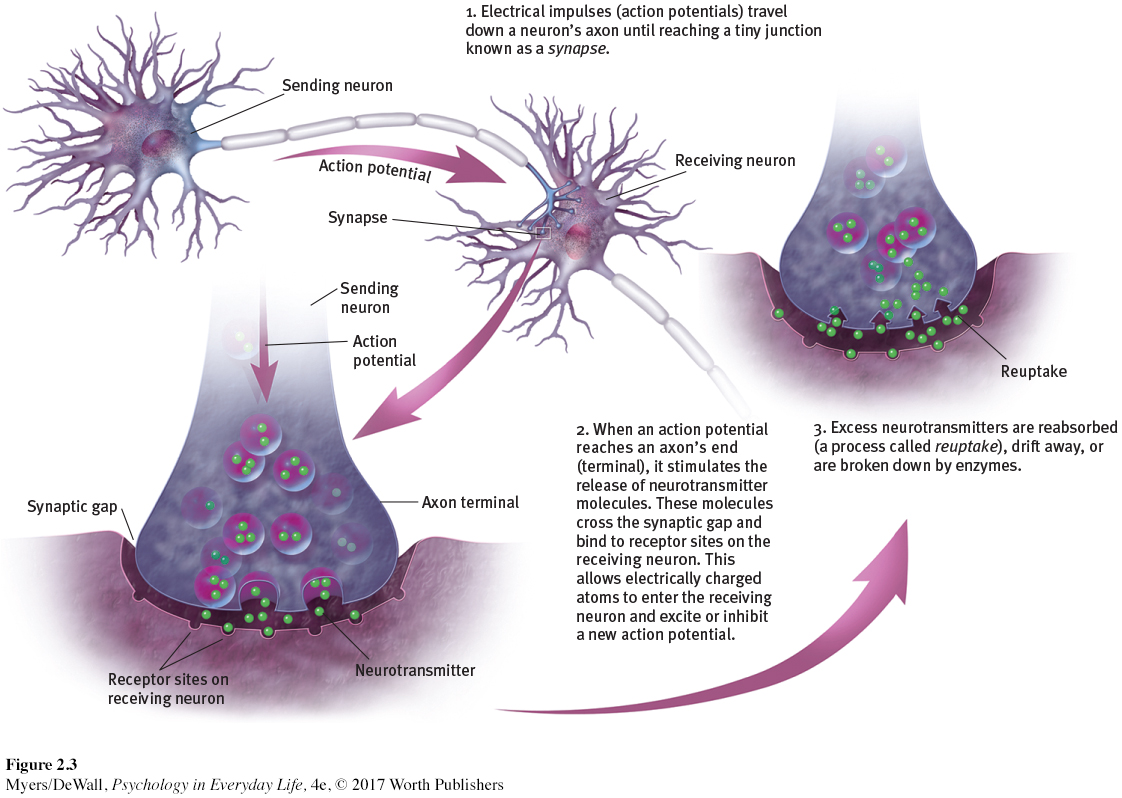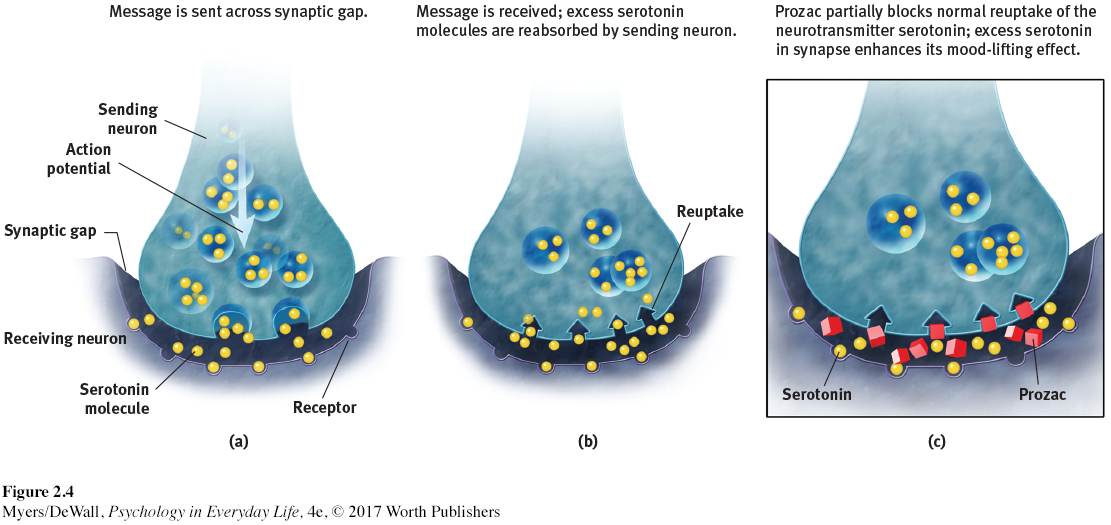2.2 Neural Communication
LOQ 2-
neuron a nerve cell; the basic building block of the nervous system.
The human body is complexity built from simplicity. Our amazing internal communication system is formed by basic building blocks: neurons, or nerve cells. Throughout life, new neurons are born and unused ones wither away (Shors, 2014).
A Neuron’s Structure
dendrites neuron extensions that receive messages and conduct them toward the cell body.
axon the neuron extension that sends messages to other neurons or to muscles and glands.
Neurons differ, but each consists of a cell body and its branching fibers (FIGURE 2.1). The neuron’s often-


action potential a nerve impulse; a brief electrical charge that travels down an axon.
glial cells (glia) cells in the nervous system that support, nourish, and protect neurons; they also play a role in learning, thinking, and memory.
The messages neurons carry are electrical signals, or nerve impulses, called action potentials. These impulses travel down axons at different speeds. Supporting our billions of nerve cells are nine times as many spidery glial cells (“glue cells”). Neurons are like queen bees—
Some action potentials trudge along at a sluggish 2 miles per hour, and others race along at 200 or more miles per hour. Can you guess which reacts faster, a human brain or a high-
synapse [SIN-
Neurons interweave so tightly that even with a microscope, you would have trouble seeing where one ends and another begins. But end they do, at meeting places called synapses. At these points, two neurons are separated by a tiny synaptic gap less than a millionth of an inch wide. “Like elegant ladies air-
“All information processing in the brain involves neurons ‘talking to’ each other at synapses.”
Neuroscientist Solomon H. Snyder, 1984
Retrieve + Remember
Question 2.3
•When a neuron fires an action potential, the information travels through the axon, the dendrites, and the cell body, but not in that order. Place these three structures in the correct order.
ANSWER: dendrites, cell body, axon
How Neurons Communicate
LOQ 2-
Each neuron is itself a miniature decision-
threshold the level of stimulation required to trigger a neural impulse.
refractory period in neural processing, a brief resting pause that occurs after a neuron has fired; subsequent action potentials cannot occur until the axon returns to its resting state.
If the excitatory signals exceed the inhibitory signals by a minimum intensity, or threshold, the combined signals trigger an action potential. (Think of it this way: If the excitatory party animals outvote the inhibitory party poopers, the party’s on.) The neuron fires, sending an impulse down its axon, carrying information to another cell. Neurons then need a tiny break before they can fire again. This resting pause, called a refractory period, lasts fractions of a second.
all-
A neuron’s firing doesn’t vary in intensity. The neuron’s reaction is an all-
neurotransmitters neuron-
reuptake a neurotransmitter’s reabsorption by the sending neuron.
When the action potential reaches the axon’s end, your body performs an amazing trick. Your neural system converts an electrical impulse into a chemical message. At the synapse, the impulse triggers the release of neurotransmitter molecules, chemical messengers that can cross the synaptic gap (FIGURE 2.3). Within one 10,000th of a second, these molecules bind to receptor sites on the receiving neuron, as neatly as keys fitting into locks. They then act as excitatory or inhibitory signals, and the process begins again in this new cell. The excess neurotransmitters finally drift away, are broken down by enzymes, or are reabsorbed by the sending neuron—


Retrieve + Remember
Question 2.4
•How does our nervous system allow us to experience the difference between a slap and a tap on the back?
ANSWER: Stronger stimuli (the slap) cause more neurons to fire and to fire more frequently than happens with weaker stimuli (the tap).
Question 2.5
•What happens in the synaptic gap?
ANSWER: Neurons send neurotransmitters (chemical messengers) across this tiny space between one neuron’s terminal branch and the next neuron’s dendrite or cell body.
How Neurotransmitters Influence Us
LOQ 2-
Dozens of different neurotransmitters have their own pathways in the brain. As they travel along these paths, they carry specific but different messages that influence our motions and emotions. Dopamine levels, for example, influence our movement, learning, attention, and feelings of pleasure and reward. Serotonin levels can make us more or less moody, hungry, sleepy, or aroused. TABLE 2.1 outlines the effects of these and other neurotransmitters.
| Neurotransmitter | Function | Examples of Malfunctions |
|---|---|---|
| Acetylcholine (ACh) | Enables muscle action, learning, and memory | With Alzheimer’s disease, ACh- |
| Dopamine | Influences movement, learning, attention, and emotion | Oversupply linked to schizophrenia. Undersupply linked to tremors and decreased mobility in Parkinson’s disease. |
| Serotonin | Affects mood, hunger, sleep, and arousal | Undersupply linked to depression. Some drugs that raise serotonin levels are used to treat depression. |
| Norepinephrine | Helps control alertness and arousal | Undersupply can depress mood. |
| GABA (gamma- |
A major inhibitory neurotransmitter | Undersupply linked to seizures, tremors, and insomnia. |
| Glutamate | A major excitatory neurotransmitter; involved in memory | Oversupply can overstimulate brain, producing migraines or seizures (which is why some people avoid MSG, monosodium glutamate, in food). |
| Endorphins | Neurotransmitters that influence the perception of pain or pleasure | Oversupply with opiate drugs can suppress the body’s natural endorphin supply. |
“When it comes to the brain, if you want to see the action, follow the neurotransmitters.”
Neuroscientist Floyd Bloom, 1993
opiate a chemical, such as opium, morphine, or heroin, that depresses neural activity, temporarily lessening pain and anxiety.
In Chapter 1, we promised to show you how psychologists play their game. Here’s an example. An exciting neurotransmitter discovery emerged when researchers attached a radioactive tracer to morphine, an opiate drug that elevates mood and eases pain (Pert & Snyder, 1973). (Radioactive tracers send out harmless but detectable energy as they pass through the body.) As researchers tracked the morphine, they noticed it was binding to receptors in brain areas linked with mood and pain sensations. Why, they wondered, would these natural “opiate receptors” exist? Might the brain have these chemical locks because our body produces a natural key—
endorphins [en-
Further work revealed the answer. When we are in pain or exercising vigorously, the brain does, indeed, produce several types of neurotransmitter molecules similar to morphine. These natural opiates, now known as endorphins (short for endogenous [produced within] morphine), help explain why we can be unaware of pain after an extreme injury. They also explain the painkilling effects of acupuncture, and the good feeling known as “runner’s high” (Boecker et al., 2008).
If our natural endorphins lessen pain and boost mood, why not amplify this effect by flooding the brain with artificial opiates, such as heroin and morphine? Because the brain does a chemical balancing act. When flooded with artificial opiates, it may shut down its own “feel-
 For an illustrated review of neural communication, visit LaunchPad’s PsychSim 6: Neural Messages.
For an illustrated review of neural communication, visit LaunchPad’s PsychSim 6: Neural Messages.
Throughout this book, you’ll hear more about the many roles neurotransmitters play in our daily lives. But let’s first continue our journey into the brain.
Retrieve + Remember
Question 2.6
•The endorphins, serotonin, and dopamine are all chemical messengers called _______ .
ANSWER: neurotransmitters